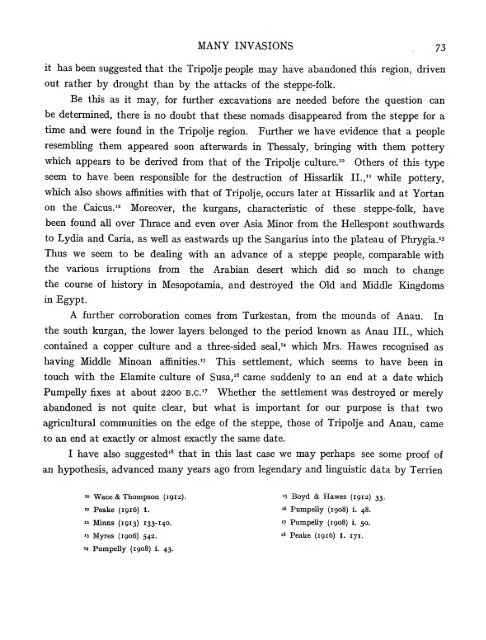The bronze age and the Celtic world - Universal History Library
The bronze age and the Celtic world - Universal History Library
The bronze age and the Celtic world - Universal History Library
You also want an ePaper? Increase the reach of your titles
YUMPU automatically turns print PDFs into web optimized ePapers that Google loves.
MANY INVASIONS ^ 73<br />
it has been suggested that <strong>the</strong> Tripolje people may have ab<strong>and</strong>oned this region, driven<br />
out ra<strong>the</strong>r by drought than by <strong>the</strong> attacks of <strong>the</strong> steppe-folk.<br />
Be this as it may, for fur<strong>the</strong>r excavations are needed before <strong>the</strong> question can<br />
be determined, <strong>the</strong>re is no doubt that <strong>the</strong>se nomads disappeared from <strong>the</strong> steppe for a<br />
time <strong>and</strong> were found in <strong>the</strong> Tripolje region. Fur<strong>the</strong>r we have evidence that a people<br />
resembling <strong>the</strong>m appeared soon afterwards in <strong>The</strong>ssaly, bringing with <strong>the</strong>m pottery<br />
which appears to be derived from that of <strong>the</strong> Tripolje culture.'" O<strong>the</strong>rs of this type<br />
seem to have been responsible for <strong>the</strong> destruction of Hissarhk II.," while pottery,<br />
which also shows affinities with that of Tripolje, occurs later at Hissarhk <strong>and</strong> at Yortan<br />
on <strong>the</strong> Caicus." Moreover, <strong>the</strong> kurgans, characteristic of <strong>the</strong>se steppe-folk, have<br />
been found all over Thrace <strong>and</strong> even over Asia Minor from <strong>the</strong> Hellespont southwards<br />
to Lydia <strong>and</strong> Caria, as well as eastwards up <strong>the</strong> Sangarius into <strong>the</strong> plateau of Phrygia.'^<br />
Thus we seem to be dealing with an advance of a steppe people, comparable with<br />
<strong>the</strong> various irruptions from <strong>the</strong> Arabian desert which did so much to change<br />
<strong>the</strong> course of history in Mesopotamia, <strong>and</strong> destroyed <strong>the</strong> Old <strong>and</strong> Middle Kingdoms<br />
in Egypt.<br />
A fur<strong>the</strong>r corroboration comes from Turkestan, from <strong>the</strong> mounds of Anau. In<br />
<strong>the</strong> south kurgan, <strong>the</strong> lower layers belonged to <strong>the</strong> period known as Anau III., which<br />
contained a copper culture <strong>and</strong> a three-sided seal,"* which Mrs. Hawes recognised as<br />
having Middle Minoan affinities." This settlement, which seems to have been in<br />
touch with <strong>the</strong> Elamite culture of Susa,'® came suddenly to an end at a date which<br />
Pumpelly fixes at about 2200 b.C' Whe<strong>the</strong>r <strong>the</strong> settlement was destroyed or merely<br />
ab<strong>and</strong>oned is not quite clear, but what is important for our purpose is that two<br />
agricultural communities on <strong>the</strong> edge of <strong>the</strong> steppe, those of Tripolje <strong>and</strong> Anau, came<br />
to an end at exactly or almost exactly <strong>the</strong> same date.<br />
I have also suggested'^ that in this last case we may perhaps see some proof of<br />
an hypo<strong>the</strong>sis, advanced many years ago from legendary <strong>and</strong> linguistic data by Terrien<br />
10 Wace & Thompson (1912). '5 Boyd & Hawes (1912) 33.<br />
" Peake (1916) 1. "' Pumpelly (1908) i. 48.<br />
« Minns (1913) 133-140. '7 Pumpelly (1908) i. 50.<br />
'3 M3n:es (1906) 542. '* Peake (1916) 1. 171.<br />
'4 Pumpelly (1908) i. 43.







